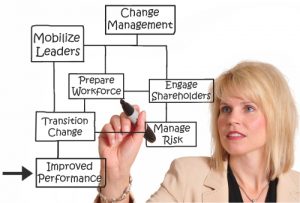Amazing PLM Governance
 In this blog series, I provide insights as to why PLM has true potential to be so transformational for life sciences companies, but many aren’t getting there. We have come a long way – we have developed a defensible strategy, picked technology, and developed a change campaign. Now we need effective governance models in place to help mitigate risk, remove obstacles and assign accountability.
In this blog series, I provide insights as to why PLM has true potential to be so transformational for life sciences companies, but many aren’t getting there. We have come a long way – we have developed a defensible strategy, picked technology, and developed a change campaign. Now we need effective governance models in place to help mitigate risk, remove obstacles and assign accountability.
In my experience, to ensure long term success, there should be at least two governance models in play.
The Program Governance Model
The first is a program governance model that considers the long term interest of the program. This model transcends any given phase and is focused on the long term vision of success and the true transformational capabilities required to smartly integrate our processes.
The program governance model should be sponsored at the most stable and highest level of the organization, and should be as impervious as possible to major organizational shifts, including:
- Restructuring (new acquisition, divestiture, and merger):Â When possible, the PLM strategy must be adapted to the changing environment. This is possible when the PLM strategy is linked to a broader business strategy and focused on business results that cannot easily be upended or removed from the three year plan. Regrettably, I have seen organizational restructuring kill otherwise fantastic PLM programs because there was a failure to adequately create this linkage. Instead, there was a reliance on the previous organizational leaders to shoulder the risk
- Change to key leadership positions:Â The PLM strategy must live beyond a single enthusiastic leader. A tight-knit group of senior sponsors can be helpful when changes occur in individual leadership roles, and when major organizational restructuring or strategic growth changes occur
The program governance team should be instrumental in removing obstacles like financing or differences between departments. Strong leaders with vision and tenacity can hold the project teams accountable.
It’s very important that the sponsors are educated on what an optimized product lifecycle could look like and that they understand the context of a broader enterprise strategy. I have been surprised by how hard it can be to educate senior leaders on these concepts. Be prepared to explain things very differently; these are very smart people but you must be able to define impacts to business results (reduced risk of recalls, reduced cost and impact of regulatory compliance, improvements in top line revenues, improved staff productivity, etc.). Remember, senior leaders don’t speak the same language as those you deal with daily about PLM.
The Project Governance Model
The second governance model is a project governance model. This must fit perfectly with the broader program governance model and reporting should be defined between the two. Project metrics should feed into the program metrics and program governance guides the requirements for project governance (for example, if we agree to certain outputs, it will be down to individual projects to generate the raw data).
At a minimum, the project governance model must address the following:
- Team management:Â Team roles and responsibilities, providing role clarity on who is responsible and accountable for what
- Methodology expectations: Ideally, your implementation is based on a delivery methodology that has been tried and tested. It’s unlikely we will do everything the methodology calls for because not every project is the same. But we need to agree on the principles we will apply when determining what aspects must be covered to ensure appropriate level of quality. In life sciences, the standard is generally very high
- Deliverable process:Â Define the process to align on deliverable expectations, review with the client, and ensure consistently high quality work
- Meeting process:Â Document what meetings will we have, who must attend, and the process for each
- Reporting expectations:Â Reporting and project governance artifacts (what reports must exist, who owns them, frequency of updates)
In subsequent entries we will dig deeper into some of these areas and look closer at what it takes to deliver them in practice, especially in the areas of teaming and methodology, which are difficult to do well.
Originally published on September 23rd, 2015 on viewpoints.kalypso.com
Wait! Before you go…
Choose how you want the latest innovation content delivered to you:
- Daily — RSS Feed — Email — Twitter — Facebook — Linkedin Today
- Weekly — Email Newsletter —
 Dave Hadfield brings over 17 years of experience in product lifecycle management (PLM) to Kalypso‘s clients, with deep expertise in the medical device industry. He is a principled business executive and respected leader with almost 19 years of experience delivering business transformation by improving the Client’s Innovation engine.
Dave Hadfield brings over 17 years of experience in product lifecycle management (PLM) to Kalypso‘s clients, with deep expertise in the medical device industry. He is a principled business executive and respected leader with almost 19 years of experience delivering business transformation by improving the Client’s Innovation engine.
NEVER MISS ANOTHER NEWSLETTER!
LATEST BLOGS
Three things you didn’t know about credit cards
Photo by Ales Nesetril on Unsplash Many of us use credit cards regularly. From using them for everyday purchases to…
Read MoreFive CV skills of a business-minded individual
Photo by Scott Graham on Unsplash The skills listed on a CV help employers quickly understand your suitability for a…
Read More


